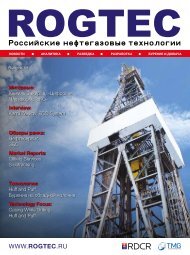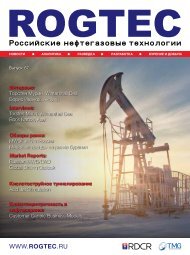ROGTEC Magazine Issue 61
Russian Oli & Gas Magazine
Russian Oli & Gas Magazine
Create successful ePaper yourself
Turn your PDF publications into a flip-book with our unique Google optimized e-Paper software.
SMART WELLS
СИИС, устанавливаемых на серийном насосном
оборудовании. Это позволило обеспечить прямой
способ дистанционной непрерывной регистрации
забойного давления и оперативную передачу
полученных данных в обрабатывающие центры.
Благодаря внедрению сертифицированных
средств измерения давления и увеличению их
чувствительности до 0,0001–0,001 МПа программа
плановых ГДИС была полностью пересмотрена.
В результате регламентные ГДИС в добывающих
скважинах проводятся без привлечения
геофизических сервисов и длительных остановок
скважин на замеры КВД и КВУ. Более того, переход
на технологии записи долговременных КСД
позволил дополнительно обеспечить контроль в
режиме реального времени:
• изменения пластового давления;
• динамики скин-фактора (показатель кольматации
прискважинной зоны) при дополнительных
фиксациях кратковременных КВУ;
• влияния соседних добывающих и нагнетательных
скважин, что позволило предотвратить прорывы
воды от нагнетательных скважин и соответственно
добиваться выравнивания фронта вытеснения
нефти водой.
На данном этапе за счет внедрения простейших
точечных дистанционных СИИС удалось многократно
сократить потери добычи нефти из-за вынужденных
длительных остановок добывающих скважин (рис. 2).
В данной инновации компания «Газпром нефть»
была первой в России. В качестве полигона
было выбрано Южно-Приобское месторождение.
Внедрение технологии позволило: отказаться от
некорректных определений забойного давления
по динамическим уровням, проводить ГДИС
практически со 100%-ным охватом добывающего
фонда, оценивать взаимовлияние скважин (принцип
гидропрослушивания), динамику скин-фактора
и пластового давления. Специалисты компании
обосновали и защитили в ЦКР Роснедра (протокол
№ 3820 от 14.09.2006 г.) технологию замены записи
длительных КВД и КВУ на записи долговременных
КСД с кратковременными КВУ (технологические
перерывы в работе ЭЦН), позже оформленную
как патент. На примере Южно-Приобского
месторождения (годовая добыча в 2018 г. составила
более 11 409 тыс. т нефти), где ежегодный эффект
от внедрения точечных СИИС оценивается на уровне
880 тыс. т дополнительно добытой нефти, можно
сделать вывод, что оптимизация добычи за счет уже
внедренных средств СИИС дает совокупный эффект
7,7 % уровня добычи месторождения. Составляющие
экономического эффекта следующие: – оптимизация
работы насосов (потенциал насосов оценивался по
oil production due to implementation of single-gauge
wellbore sensors is estimated at 880 thousand ton. It can
be concluded that optimization of oil production driven
by the technical means that have been already deployed
cumulatively results in 7.7% of field oil production.
Components comprising economic benefit are the
following: optimization of pumps performance (potential
pumps capacity was estimated out of dynamics of data
obtained by wellbore sensors) – more
than 1.8%; selection of candidate wells for refracking
taking into account interference of offset wells (estimated
data obtained by wellbore sensors) – more than 1.3%;
leveling of oil displacement and redistribution of water
injection (including reduction of injected water volume in
order to exclude water breakthrough due to self-induced
hydraulic fracturing) – more than 1.8% (not taking into
account effect of non-efficient injection decrease); target
boosting of reservoir pressure maintenance system –
1.7%; reduction of direct oil production losses due to
switching from acquisition of pressure and level buildup
curves to real-time acquisition of level stabilization
curves – not less than 1.1%. At this stage apart from
single-gauge wellbore sensors providing wellbore
hydraulic measurements, there was also implementation
of autonomous remote multiple single-gauge sensors
each consisted of a flowmeter, water-in-oil meter,
thermometer and pressure gauge; they were installed at
different depths in vertical and directional wells (usually
at the top of co-produced oil formations). Remote data
transmission from these multiple-measurement devices
(for example if ‘Sprut’ (‘Octopus’) design developed
by ‘Geofizika’ research and production company was
implemented) has been achieved by 2 ways:
1) In production wells – a power supply cable sits
inside a pump telemetry unit is connected to a string
of sensors; the latter is suspended below the electric
submersible pump within a perforated zone;
2) Injection wells, with dual injection equipment, a
separate additional cable is used.
Unconventional oil deposits produced
mostly by horizontal wells with multi-stage
fracking have been identified as optimum
candidates for performing the studies with
distributed fiber-optic systems.
This type of single-gauge-distributed wellbore sensors
deployed at the Yuzhno-Priobskoe field with wells
equipped with Y-tool bypass systems which allowed
targeted monitoring of producing wells equipped with
multizone completions. This permanent geomonitoring
resulted in reliable quantitative data regarding multiphase
fluid movement and composition (under conditions
of pumping-assisted production of formations); and
variations of the filtering parameters within produced oil
www.rogtecmagazine.com
ROGTEC
61















